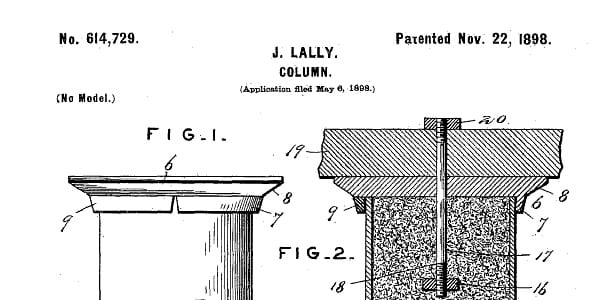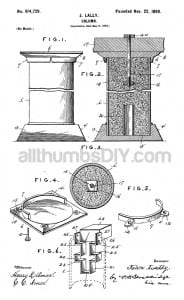
After establishing his home Waltham, MA John Lally went to work for a local contractor named Glancy, a kindly architect who taught John how to read blueprints and to estimate the costs involved in construction. At 27, under Glancy’s tutelage, John became a Master Mason. On of his first bids was for erecting a Methodist Church in the Watch City’s Central Square.
As the nineteenth century drew to a close, John was the largest contractor of his kind in Waltham, building there and elsewhere scores of private homes, schools, churches, factories, banks, and other major works, including business blocks and a subway.
Now thoroughly immersed in all phases of construction, John Lally knew his trades well enough to spot flaws and deficiencies and then to devise means of improving the quality of work being done.
Imaginative and a good mechanic himself, he invented such diverse tools as a fireplace damper and chimney hood, an adjustable trowel, a plastering machine, a double-headed nail and many more. It was while thus experimenting with concrete that John Lally invented the column that has borne his name for over 100 years.
Upset by the destruction and loss of life that so frequently accompanied a fire or building collapse, John searched for a method by which structures could be made sturdier and less flammable. A stronger support, he reasoned, would lessen the chances of a building settling, sagging, or even toppling, and a flame-proof support would virtually eliminate the sort of collapse that ensued when mere timber rotted, broke or was weakened by fire. The result was The Genuine Lally Column.
 At first,Lally experimented with a galvanized tin casing and cement of different consistencies. As he progressed, using pipes of varying circumferences, thickness, and length, with fine and coarser cement, he brought his examples to the Watertown Arsenal for testing on the most sophisticated equipment of its kind in the U.S.
At first,Lally experimented with a galvanized tin casing and cement of different consistencies. As he progressed, using pipes of varying circumferences, thickness, and length, with fine and coarser cement, he brought his examples to the Watertown Arsenal for testing on the most sophisticated equipment of its kind in the U.S.
Results showed that one early Lally column – a galvanized in pipe 17 inches long, 2.95 inches in diameter, and filled with concrete- sustained a load of 44,600 pounds or 6,568 to the square inch. John’s patent (USPTO 614729) was granted on November 22, 1898. Over the next eight years and more, Lally subjected his column to more than a thousand strength tests.
By the first decade of the 20th century Lally had triumphed: he had his own plant in Waltham, then in Cambridge, branches in Brooklyn and Chicago. When it was found to be directly responsible for saving both property and lives at a disaster in the Plant Shoe Factory in Jamaica Plain, and later at massive fires in Chelsea and Salem, the Genuine Lally Column had found its place in construction history.
If you want to learn more about how Lally columns are used in home DIY projects, click here.
REFERENCES
- Galway Inventor’s Brainchild Supports the World – George E. Ryan (Irish News, Sept 1984)

Max
Sunday 10th of January 2021
For some reason when I clicked this link, I became terrified that I was going to be Rickrolled.
Interesting read, thank you.
Adjustable Split Jack Post - A Best Home Inspection | A Best Home Inspection
Thursday 10th of April 2014
[…] Originally a lolly or Lally Column was a proprietary name for the concrete filled, solid steel column invented by John Lally. Many people feel that the term should only be spelled “Lally” and that it should only be applied to concrete filled steel columns. “ For more on the Lally Column see: John Lally History.” […]
Reviews – Lolly / Lally columns or Jack Post or Floor Jacks
Wednesday 15th of August 2012
[...] If you want to know more about John Lally and his US Patent #, read my post “John Lally History [...]